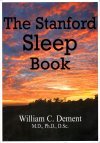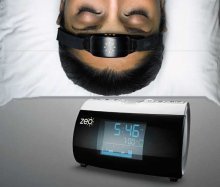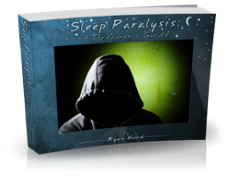
| Connect & Subscribe |
Narcolepsy: Life is short, stay awake for it!
A Brochure
An Outreach Project by Karee JuVette | Return To Outreach Projects 2010
The following is a brochure created for Stanford Sleep and Dreams. If it is difficult to read using the images, you may view the full text here.
Also feel free to download this brochure for distributional or general information purposes. Please refer to our privacy policy for our relevant disclaimers.
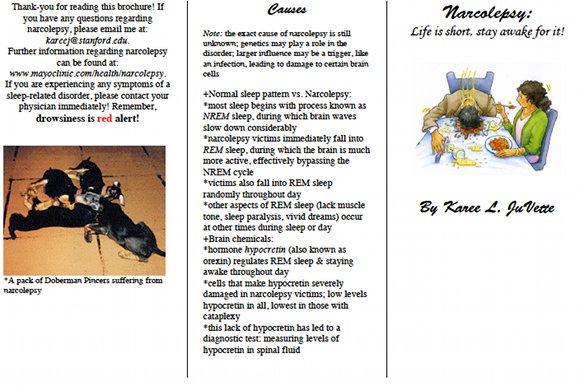
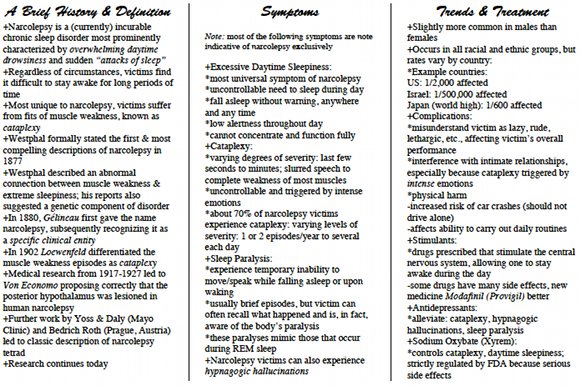
A Brief History and Definition
Symptoms
Note: most of the following symptoms are note indicative of narcolepsy exclusively
Excessive Daytime Sleepiness:
+Cataplexy:
Sleep Paralysis:
Narcolepsy victims can also experience hypnagogic hallucinations
Trends and Treatment
Complications:
-affects ability to carry out daily routines
Stimulants:
Sodium Oxybate (Xyrem):
Causes
Note: the exact cause of narcolepsy is still unknown; genetics may play a role in the disorder; larger influence may be a trigger, like an infection, leading to damage to certain brain cells
Normal sleep pattern vs. Narcolepsy:
Brain chemicals:
Thank-you for reading this brochure! If you have any questions regarding narcolepsy, please email me at:
kareej[at]stanford.edu.
Further information regarding narcolepsy can be found at: www.mayoclinic.com/health/narcolepsy.
If you are experiencing any symptoms of a sleep-related disorder, please contact your physician immediately!
Remember, drowsiness is red alert!
About This Site
Welcome! This site is continuously being created by students of Dr. William C. Dement's Sleep And Dreams course at Stanford University.
We made this site as a call to action for people all over the world to live healthier, happier, safer, and more productive lives by learning about their own sleep. We have faith that reading the information provided on this site will motivate you to be smart about your sleep deprivation and strategic about your alertness in order to live life to your fullest, most energetic potential.
In fact, we challenge you to do so! What do you say, are you up for the challenge?
Interviews With Sleep Specialists: Insights Into the Worlds of Sleep Medicine & Sleep Business
America's Most Dangerous Disorder: What Is Sleep Apnea Doing To Your Sleep?
Sleep Debt: How Much More Will You Achieve When You Reduce Yours?
The Stages Of Sleep: The Journey Through The Night
Delayed Sleep Phase: You Want To Sleep But You're Not Tired Yet
Paralyzed at Night: Is Sleep Paralysis Normal?
Sleep In Words: Smart, Strange, and Funny Quotes About Sleep
Sleep Disorders In Children: What's Keeping Your Child From A Full Night's Rest?
Attacks of Pavor Nocturnus (a.k.a. Sleep Terrors, Night Terrors, or Incubus Attacks)
The Stanford Sleep Book
Dr. Dement's pioneering textbook has been the core text for Sleep and Dreams since 1980, but it has just recently been made available to the wider public for the first time.
In it you'll find a more detailed account of the most important things you need to know about sleep, alertness, dreams, and sleep disorders. Studies, statistics, plus plenty of Dr. Dement's classic anecdotes painting the history of sleep medicine.
Preface | Intro | Contents | Get A Copy
More Sleep Resources
The Zeo
A revolution in personal sleep tracking, the Zeo is a wireless headband that transmits your brainwaves in realtime to a dock (pictured here) or your smartphone. The result? You can wake up and see exactly what stages of sleep you were in during the night! Unprecedented personalized sleep knowledge.
Sleep Paralysis: A Dreamer's Guide
Ever woken up paralyzed? A surprising number of us have, believe it or not. But few know the actual causes of this phenomenon, and fewer still how to exert control over it. Dream researcher and sleep paralysis expert Ryan Hurd shares breakthrough insights into how to do just that.
Important Disclaimer
Please Note:
The information found on this page and throughout this site is intended for general information purposes only. While it may prove useful and empowering, it is NOT intended as a substitute for the expertise and judgments of healthcare practitioners.
For more info, see our
Terms of Use.







